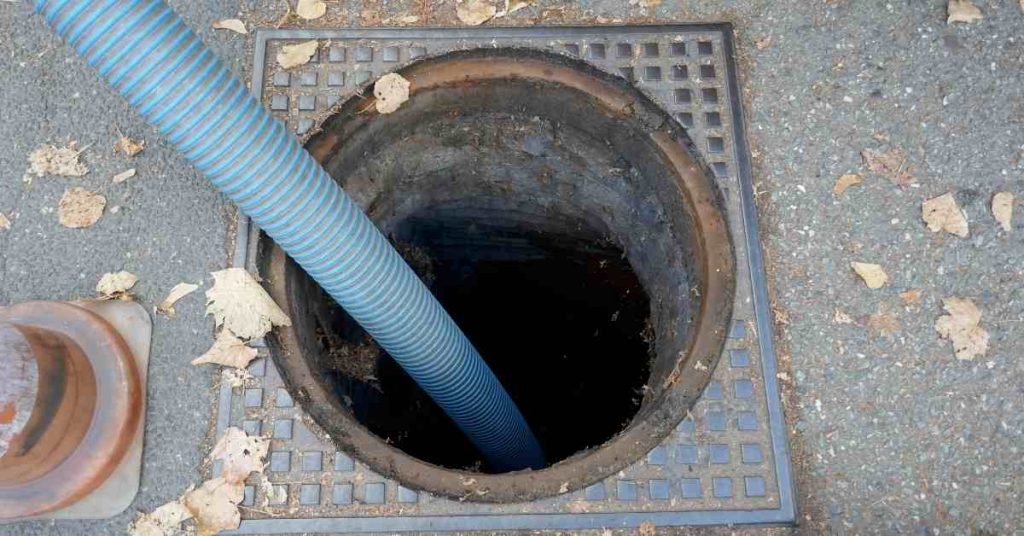
Recognizing the signs that your septic tank is full and needs to be emptied is essential for maintaining a properly functioning septic system. Here’s a brief summary of these signs:
- Slow Drains: One of the early signs of a full septic tank is slow drainage in sinks, showers, and toilets. If multiple drains are slow simultaneously, it may indicate a full tank.
- Odors: Unpleasant sewage odors around your home, especially near the drainfield or over the septic tank, can signal that the tank is reaching capacity.
- Sewage Backup: If sewage backs up into your drains or toilets, it’s a clear indication that the septic tank is full or experiencing a blockage.
- Lush Grass or Standing Water: An unusually lush and green patch of grass over the drainfield, or standing water or puddles in the yard near the tank or drainfield, may suggest that the tank is full and wastewater is surfacing.
- Gurgling Sounds: Gurgling sounds coming from drains or toilets can indicate a problem with the plumbing system, which may be related to a full septic tank.
- High Septic Tank Levels: In some cases, you can check the septic tank’s level by removing the lid and using a measuring stick or probe. If the level is near the top, it’s a sign that the tank needs to be emptied.
- Inspection Records: Regular septic tank maintenance and inspection records can provide insight into when the last pumping occurred. If it’s been several years since the last pump, it’s likely time for another service.
- Increased Water Usage: A sudden increase in water usage, such as hosting a large event or doing excessive laundry, can overload the septic system and lead to faster tank filling.
How Often Should a Septic Tank be Emptied?
You do not have to wait until you have slow drains, pooling water, sewer odors and other signs in order to have your septic tank emptied. It is better to do it before all those problems start.
I can promise you it is cheaper to just have your septic tank pumped instead of having to replace a clogged drain field or dealing with sewage backups. Plumbers charge a lot for that such kinds of jobs.
Ideally, a septic tank should be emptied once every 3 or 5 years. The frequency depends on the size of the septic tank and the amount of wastewater generated by the household. Large households with more wastewater will need to have their septic tanks emptied frequently.
It is important to mention that just because a septic tank is working as it should does not mean that it is not full. The best practice is to have it emptied before problems start.
But how do you if your septic tank is full?
The only way to tell if you septic tank is full is by locating it and lifting off the lid. With the lid out, you can see the level of wastewater inside the septic tank and decide if it is time to have it emptied or not.
If you don’t know where your septic tank is located or even if you have one, I have written a separate post on the same. Read it here.
A full septic tank means different things to different people. There are at least 3 ways to describe a full septic tank as outlined below:
Tank filled to normal level
When a septic tank is filled to the normal level, it means that the outlet pipe is allowing water to flow to your drain field.
When the septic tank is emptied, the water level falls but rises again as more solids are deposited at the bottom of the tank.
Sludge has accumulated
As more waste is drained into the septic tank, the solids (sludge) settles at the bottom of the septic tank and accumulates gradually. When the septic tank goes past its normal fill level, more solids are deposited in the tank and at the time it will need to be emptied.
The good thing is that at this time, wastewater is still flowing out to the drain field without a problem.
Overfilled septic tank
With an overfilled tank, the drain field will stop taking/accepting water from the septic tank. As a result, the wastewater will start to backup to the overflow tank and the water level will rise to the very top.
You want to avoid such a scenario in your property and that is why it is important to have your septic tank emptied in a timely manner.
Signs a Septic Tank Needs to be Emptied

Let us now look in more details at the telltale signs of a full septic tank and one which needs to be emptied.
1. Pooling/Standing Water
The way a septic tank work is that as wastewater flows in the tank, it is broken down by bacteria and the solids settle at the bottom while the scum (fats, grease etc.) settle at the top. ‘Clean water’ is usually in the middle.
The solids (sludge) should be pumped out before it reaches the septic tank’s outlet pipe. If that does not happen, you will have sludge flowing out into the drain field which should not happen.
In case you don’t know, a drain field consists of a series of pipes with small holes through which clean water from the septic tank is allowed back to the ground. It is also known as a leach field.
When the sludge enters the drain field, it clogs the holes meaning that water cannot flow out and if it does, it only flows out through a few holes which end up overwhelming the ground resulting in pooling water in the drain field.
Another thing that can happen is that the water will accumulate in the outlet pipe and when pressure builds up it will backup to the septic tank and overflow. As a result, you will end up with standing water close to the septic tank.
If you see pools of water in your drain field or around the septic tank then you need to have your septic tank emptied as soon as possible.
2. Sewer Smell Outside
A sewage smell outside the house can be caused by a full and overflowing septic tank but it could also be caused by a leaking sewer line or even a plumbing vent that is not properly installed.
If there is a sewer smell coming specifically from the drain field, there is a very high likelihood that your septic tank is full and needs to be emptied.
Usually, the water flowing from the septic tank to the drain field has no smell. It becomes smelly when the sludge level in the septic tank is too high and some of it starts to access the drain field.
When this sludge is deposited in the drain field and then temperature rises, an awful smells will start to come from that area. It is usually very costly to fix a clogged/smelly drain field.
A properly functioning septic tank should not smell though. The thing about smells is that if you have a smelly lawn, it will not only affect you but the neighbors as well.
The best thing is to have the septic tank emptied immediately there is a sewage smell in your property. At that time, the drain filed will not be clogged yet but if you wait longer it will be.
3. Slow Drains

If you that notice all your fixtures (not just one) are draining slowly, there is a high chance that your septic tank is full and needs to be emptied.
As you can imagine, if your septic tank as well as its outlet pipe is full, a restriction will be created and water from your drains will have to force its way in and hence the slow drains.
Having said that, a full septic tank is not the only thing that can cause slow drains. You could be having a partial clog in your main drain line which also creates a restriction resulting in slow drains.
Another reason why you could be having slow drains is a clogged plumbing vent. A plumbing vent allows air into the drain lines which is what allows them to drain fast.
When the vent is clogged, air cannot get into the drain lines and as a result you will end up with slow drains and weak flushing toilets.
4. Unusually Green Lawn

Is the grass around your septic tank greener and healthier than in other places in your property? That could be an indication that your septic tank is full and overflowing.
The wastewater from a septic tank contains organic fertilizer which when combined with the moist ground nourishes the grass resulting in speedy growth compared to other areas of your property.
Greener patches of your lawn could also be caused by a leaking sewer line. You can investigate the problem yourself or have a drainage expert come over and inspect it for you.
5. Sewage Backup
Other than a clogged drain field, one problem you do not want to have is sewage backing up to your house from a septic tank.
Not only is sewage backup disgusting, it is also very expensive to fix and could damage your property if not fixed promptly. Raw sewage in your house is also a health hazard to you and your family.
When wastewater cannot flow out of the septic tank to the drain field, it will start backing up in the sewer line. When more wastewater is drained out of fixtures, it will be forced out through drains in the lowest level of your house which for most people is the basement.
If you have sewage backing up to your house, contact a professional plumber immediately. At the same time, do not use any water in your house to prevent more sewage from backing up.
6. Gurgling Drains
Before you have sewage backing up to your house, you will experience gurgling drains. Another thing to watch out for is a toilet that bubbles when flushed or when another fixture drains.
When the water in the main drain line accumulates such that it prevents the plumbing vent from bring in air, a vacuum will be created inside the drain line which will suck water from drain traps when other fixtures drain and hence the gurgling sounds.
It is however not always the case that when you have gurgling drains you have a full septic tank. The problem could also be caused by a blocked vent stack.
7. Weak/Slow Flushing Toilet
For a toilet to flush strongly, there needs to be air in the drain line which is what helps to create a strong siphon (suction) when your pull the flushing handle.
With a full septic tank, there is already water inside the drain line sometimes completely blocking off the plumbing vent and as result no air in the drain line. When that happens you toilet will end up with a weak flush.
Taking Care of Your Septic Tank
- Unless it is human waste or toilet paper, don’t flush it down a toilet.
- Don’t pour grease in the kitchen sink drain.
- Have the septic tank emptied every 3 to 5 years
- Create a schedule for your septic tank emptying. It is determined by size of household, septic tank size and amount of wastewater generated
- Don’t move heavy machineries on top of the septic tank or sewer line.
- Don’t plant deep rooted plants near the septic tank.
- Avoid chemical drain cleaners at all costs.
- Use septic-safe toilet paper.
Check out this post for more details on how to take care of your septic tank.
And basically that is pretty much it about the signs of full septic tank. I hope this guide was helpful.





